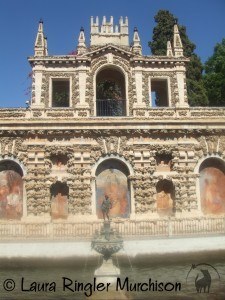Our last day was spent in the capital of Seville. After the “discovery” of the Americas, it became one of the economic centers of the Spanish empire with its port monopolizing the trans-oceanic trade. As a person proud of their Native American heritage, I confess this particular city did not sit well with me. I understand it happened in the past, but, for me at least, it still seriously rankled. We all know Christopher Columbus set sail for the “New World” and hit land in 1492. I wonder how many know of the heinous atrocities committed after he landed? He and others such as Hernando de Soto and Cabeza de Vaca slaughtered thousands of innocents and enslaved the rest searching for riches not theirs to be plundered. It sickens me. And then there was the dreaded encomendia system which whipped Native Peoples into submission and enslavement all under the name of God, King and Country (Spain). If you care to research this further, do yourself a favor: they say history is written by the victors. Do not read some glossy bio of the “great explorers”; rather I encourage you to look deeper and find reading material giving a more truthful historical account of what Europeans did to Native Peoples. I created my own minor at SMU in Native American studies and if anyone is really interested I can send you book titles. But I digress. This day we would see the Seville Cathedral, the largest gothic cathedral and the third largest church in the world. I had a visceral reaction to seeing Christopher Columbus’ crypt. I just remember lots of gold and silver and felt I should leave because it was not good to be filled with such hatred in a house of God; really anywhere for that matter. Outside it was hot — sweat trickling down your back hot. I found myself worrying about the horses who were giving carriage rides at the Maria Luisa Park. Pictured here is the Plaza de España complex, a huge half-circle with buildings continually running around the edge. It is surrounded by a moat accessible by several beautiful bridges. In the center is a large fountain and the walls of the plaza have tiled alcoves, each representing a different province of Spain. Last, we visited the Alcazar of Seville. A royal palace originally developed by Moorish Muslim Kings, it is renowned as one of the most beautiful in Spain and regarded as one of the most outstanding examples of mudéjar architecture found on the Iberian Peninsula. The main entrance to the Alcázar takes its name from the 19th century tile work inlaid above it, a crowned lion holding a cross in its claws bearing a Gothic script. I loved the rounded doorways and the dark blue tile work. The gardens were beautiful, as was the reflecting pool. I found myself idly watching the koi swirling their tails languidly in the heat of the mid-day sun and missing our own koi at home in our beautiful, tiny pond. With this, I knew I was ready to come home. As our van wound its way back up the sharp twists and turns of the cobblestone streets of Vejer past the white washed buildings for the final time I was looking forward to one last sangria and cigar.
“Journalism can never be silent: that is its greatest virtue and its greatest fault. It must speak, and speak immediately, while the echoes of wonder, the claims of triumph and the signs of horror are still in the air.” ~ Austrian-born former managing editor of Time magazine Henry Anatole Grunwald

